January 26th, 2016 What’s Up?
Most of Monday was spent putting photographs in the Southern Ocean Photography Guide. And answering a zillion e-mails as always.
Though the pool has been quite chilly, I have been swimming every day. It was in the mid-thirties on Sunday evening and the pool was down to 68 degrees when I checked early on Monday morning. By the time I got in the pool it was up to 70. I did some core exercises and enjoyed a nice ice bath; the water was 59 degrees when I got out.
I learned yesterday that Walt Thomas sold his Canon 100mm f/2.8L IS macro lens and that Erik Hagstrom sold his Canon 24-70 f/2.8L lens as well. Both had recently lowered their prices; it is all a matter of supply and demand. You can see all the current listings here; there are some truly amazing values…
|
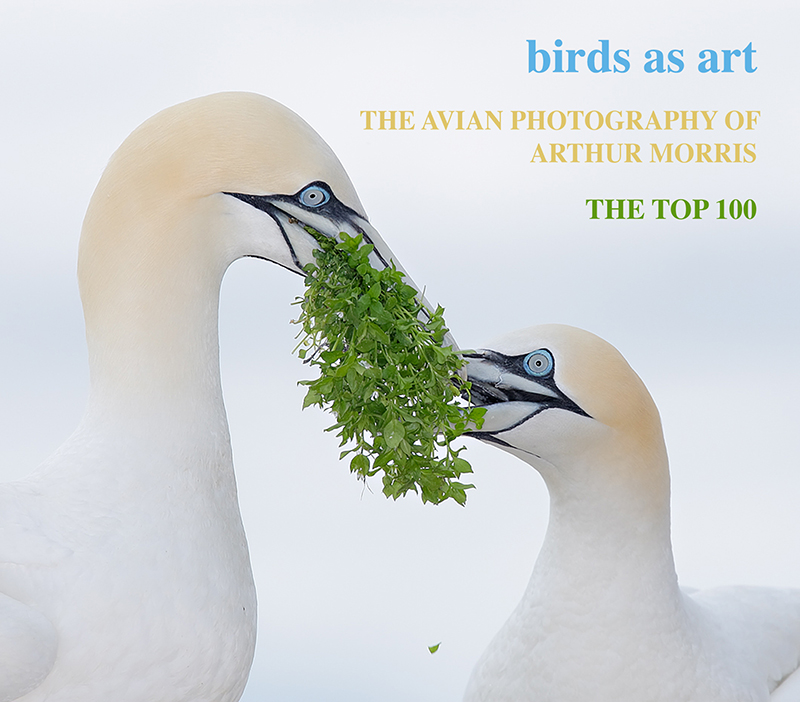
|
birds as art: The Avian Photography of Arthur Morris/The Top 100
The companion e-book to the solo exhibit at TheNat, San Diego, California
The new e-book on CD is available here. The new e-book via is also available via convenient download for $20 by clicking here.
|
What They Are Saying
The new e-book has received only rave reviews. By phone, BAA-friend Bill Goodhew advised that I should raise the price to a more realistic $50. We have heard from a few folks as below and would love to hear from more of you.
Jim Amato via comment at yesterday’s blog post
Betidings birders, Arthur’s CD, The Avian Photography of Arthur Morris, arrived today. It is a magnificent album of beautiful birds captured in their wonderful habitats. You gotta have this compilation of astounding work. Arthur has presented many, maybe all, of these images on this blog and as striking as they are on the blog, they blast off the screen on my 27 inch iMac. They will create neighborhood hysteria if shown on the new OLED 70 inch televisions. Click on the link and order a copy now! I am not related to, do not work for or volunteer with Arthur or BAA. This is one excellent CD of our feathered friends.
From Multiple IPT Veteran Doug West
I just received The Top 100 CD! I felt like a kid checking the mailbox to see if it had come! Here’s my review:
The first thing I fell in love with was the packaging. At first I didn’t think that the CD was in there due to the photo on the CD blending in with the background photo; I think my heart stopped for a second. The images of course are gorgeous. Art could’ve picked his bottom 100 images and those would still be my top 100. How in the world this man picked 100 images from roughly 32 years of doing this is amazing.
If I had to pick my favorite image, it would be on the displaying frigatebird on Page 14 – Showing Off. This one really threw my head back. I think it was due to the fact it almost looks like three different birds: the bird displaying and the two different ways the layers of feathers are laid out. The background making it pop out is the kicker.
Reading the notes and details is always fun, but I also like to read between the lines. There might be a few people who will bring up that there isn’t a year listed for each image. An estimate can be figured out if you pay attention to the camera body that was used. I counted at ‘least’ 12 different bodies by the way.
This CD is a fantastic teaching tool for those who study the images. Remember to look carefully at the head angles and the composition, the behavior, or the action. Then try to apply it yourself the next time you go out. Doug
From Multiple IPT Veteran Stephen Leimberg
Art, this is the most beautiful book on bird photography I’ve ever seen! What an inspiration! A visual feast! Bravo! Warmest, Steve
From Mike Moore via e-mail
The top 100 collection is almost too overwhelming to absorb at once. I will be looking at it many, many times to be able to drink it all in. I will say I never really appreciated blurs, but Cottonwood Morning Wave is one of my favorite images. The colors and the composition are superb. There is a real feeling of being present at a live event that a sharp photo would not have conveyed, so maybe you won me over. You give a 100 great examples of something for us to strive for. I especially appreciated that you annotated every image to get a sense of what it took to capture it. Brilliant. Congratulations and thanks for sharing and making it so affordable to own this collection of some of the world’s greatest bird images.
From IPT Veteran Larry Master via e-mail
I just downloaded your new collection of 100 images! Wow! I’ve seen many before in your posts but to view as one collection it is amazing. Larry
Additional Feedback Requested
If you ordered via download or have already received your CD, I would love to hear what you think. Please do leave a comment or shoot me an e-mail.
|

|
|
From upper left clockwise to center: Black Skimmer head portrait, American Oystercatcher dining on surf clam flesh, Common Tern at sunset, Common Tern adult swallowing flatfish, Black Skimmer in flight, newborn Common Tern chick, American Oystercatcher with chick, fresh juvenile Common Tern (with fill flash), and Common Terns copulating.
|
Nickerson Beach Terns/Skimmers/Oystercatchers Instructional Photo-Tour (IPT): July 18-22, 2016. 4 1/2 DAYS: $1899.
Meet and greet at 3pm on the afternoon of Monday, July 18. Limit 10.
The primary subject species of this IPT will be the nesting Common Terns. The trip is timed so that we will get to photograph tiny chicks as well as fledglings. There will be lots of flight photography including adults flying with baitfish. Creating great images of the chicks being fed is a huge challenge. In addition to the terns we will get to photograph lots of Black Skimmers courting, setting up their nesting territories, and in flight (both singles and large pre-dawn flocks blasting off). Midair battles are guaranteed on sunny afternoons. And with luck, we might even see a few tiny chicks toward the end of the trip. We will also get to photograph the life cycle of American Oystercatcher. This will likely include nests with eggs and tiny chicks, young being fed, and possibly a few fledglings.
Nesting Piping Plover is also possibly. There will be lots of gulls to photograph; most years I am able to find a few Lesser Black-backed Gulls of varying ages in addition to the Herring, Ring-billed, and Great Black-backed Gulls. You will learn to identify and age the various gull species. There will likely be some Willets feeding along the surf and with luck we might get to photograph a handsome juvenile or two. In addition to the locally breeding shorebirds, we will likely get to see some southbound migrant arctic-and sub-arctic breeding shorebird species such as Sanderling, Semipalmated Plover, and maybe even Red Knot.
|
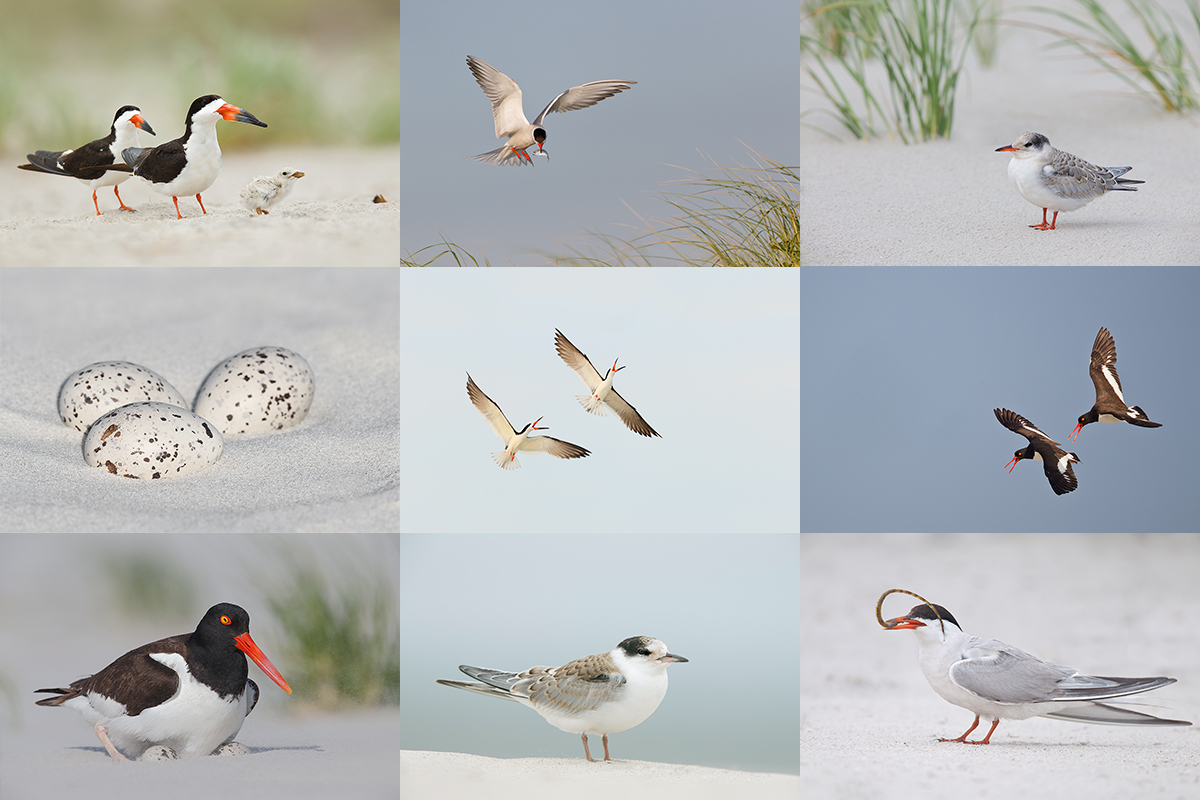
|
|
From upper left clockwise to center: Black Skimmers with tiny chick, Common Tern landing with baitfish for young, fledged Common Tern chick in dunes, American Oystercatchers/display flight, adult Common Tern with pipefish for chick, Common Tern fledgling in soft light, American Oystercatcher on nest with eggs, American Oystercatcher 3-egg clutch, battling Black Skimmers.
|
The IPT Logistics
The tour will begin with our meet and greet on the afternoon of Monday, July 18, 2016. That will be followed by our first shooting session at the beach. From Tuesday through and including all of Friday we will have two photography sessions daily. Our morning sessions will start very early so that we are on the beach well before sunrise. We usually photograph for about four hours. Then we will enjoy a group brunch. We will always have a midday break that will include a nap for me. That followed by our daily afternoon classroom sessions that will include image review, workflow and Photoshop, and a review/critique of five of your trip images. Folks are always invited to bring their laptops to brunch for image sharing. I always have mine with me but heck, I am a big show-off. Afternoon in-the-field sessions generally run from 5pm through sunset.
Breakfasts are grab what you can. Four brunches are included. Dinners (if at all) will be on your own as we will often get back to the hotel at about 9pm. There is a fridge in every room and a supermarket within walking distance of the hotel so nobody should starve. You will learn a ton during the nine shooting sessions, the four in-classroom sessions, and even at lunch. Early morning and late afternoon parking is free. If we want to head back to the beach early we will need to arrange tight carpools and share the $30/vehicle parking fee. Non-photographer spouses, friends, or companions are welcome for $100/day, $450 for the whole IPT.
Save a space by calling Jim or Jen at the office at 863-692-0906 and arranging to leave your deposit of $599–credit cards are accepted for deposits only. Your balance will be due on April 18, 2016. I hope that you can join me for what will be an exciting and educational IPT.
Card Image Question
Click on each IPT card to enlarge it. Then leave a comment letting us know which is your very favorite image. And do let us know why. While I love ’em all, I will share my three favorites with you here soon.
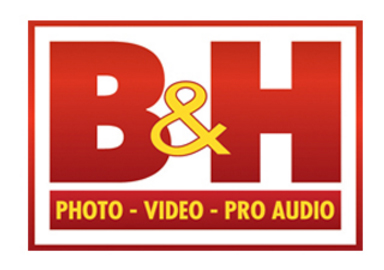
B&H
B&H contributed generously as the primary SDNHM exhibition sponsor. Thank them (and me for the blog) by clicking on the logo link above to shop.
Please Remember to use our Affiliate Links 🙂
To show your appreciation for my continuing efforts here, we ask, as always, that you get in the habit of using my B&H affiliate links on the right side of the blog for all of your photo and electronics purchases. Please check the availability of all photographic accessories in the BIRDS AS ART Online Store, especially the Mongoose M3.6 tripod heads, Gitzo tripods, Wimberley heads and plates, LensCoats and accessories, and the like. We sell only what I have used, have tested, and can depend on. We will not sell you junk. We know what you need to make creating great images easy and fun. And we are always glad to answer your gear questions via e-mail. I just learned that my account was suspended during my absence; it should be up and running by Monday at the latest.
I would of course appreciate your using our B&H affiliate links for all of your major gear, video, and electronic purchases. For the photographic stuff mentioned in the paragraph above we, meaning BAA, would of course greatly appreciate your business. Here is a huge thank you to the many who have been using our links on a regular basis and visiting the BAA Online store as well.
Facebook
Be sure to like and follow BAA on Facebook by clicking on the logo link upper right. Tanks a stack!
Typos
In all blog posts and Bulletins, feel free to e-mail or to leave a comment regarding any typos or errors. Just be right 🙂
January 25th, 2016 What’s Up?
I was thrilled that the Denver Bronco defense consistently put Pretty Boy Tom Brady on his ass in the big playoff game yesterday; the Broncos and class-act Peyton Manning are on the way to the Super Bowl. Don’t get me wrong, I have great resect for Brady and what he and Bellicek have accomplished. That last touchdown with Brady under constant pressure and Gronkowski injured yet again was heroic. But justice was served as their two-point conversion attempt failed. What really bothers me about the Patriots is that for the past ten years or so the media always wants to give the Super Bowl rings to New England even before the season starts…
As much as I would like to see Peyton join his kid brother Eli as a two-time Super Bowl winner–both of Eli’s wins of course coming against the highly favored Patriots–it is hard to conceive that Denver can prevent the eventual and inevitable supremacy of the young, strong, and talented Carolina Panthers and their Superman QB, Cam Newton. But heck, as New England finds out often, that’s why they play the games…
And lets’s not forget that the Patriots’ Super Bowl win last year was made possible only by Pete Carroll’s gift via the inane call on first and goal from the one yard line…

B&H
B&H was the primary exhibition sponsor of my solo, career retrospective, 67-image exhibit at the San Diego Natural History Museum. Thank them (and me, for the work I do on the blog) by clicking on the logo link above to shop for camera bodies and lenses.
|
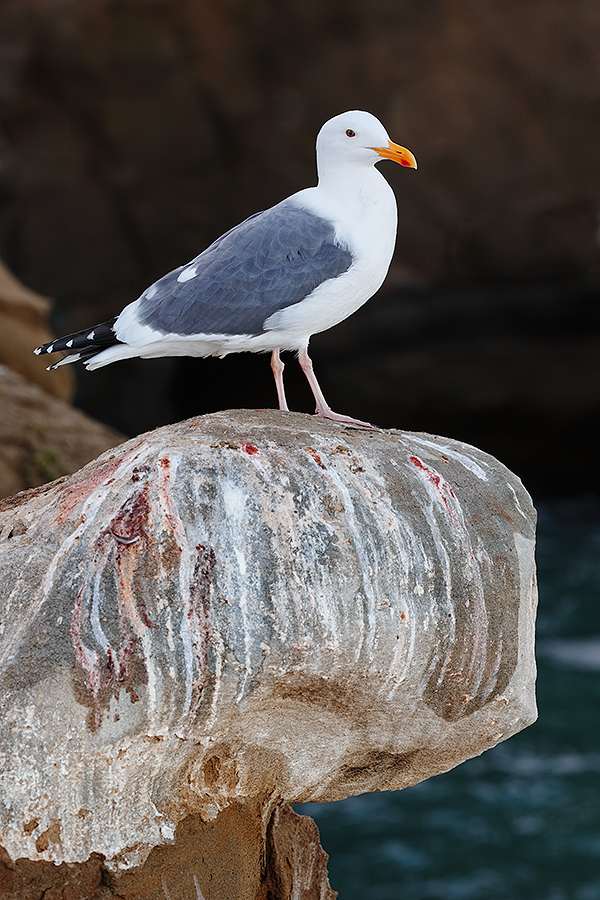
|
|
This image was created at La Jolla, CA on the 2015 San Diego IPT with the hand held Canon EF 100-400mm f/4.5-5.6L IS II USM lens (at 200mm) and the rugged Canon EOS-1D X. ISO 400. Evaluative metering -2/3: 1/125 sec. at f/9. AWB.
The AF point that was three AF points up from the center AF point/AI Servo/Expand/Rear Focus AF as framed was active at the moment of exposure (as is always best when hand holding). The selected AF point fell on the bend of the wing just above the front leg where the dark gray of the wing met the white flank. Click here to see the latest version of the Rear Focus Tutorial. Click on the image to see a larger version.
Adult Western Gull on whitewashed sandstone rock
|
Crappy Image…
I loved the whitewash on the rock at first sight. I had actually photographed the rock alone the day before. But the adult Western Gull was the icing on the frame. After figuring the correct exposure via histogram check, it took me about 20 tries to fine tune the composition. The image design here is the great strength of this photograph. Notice the following:
- The borders in front of and below the whitewashed rock; the trick was to choose an AF point that would get the bird high enough up in the frame to allow for the border below the rock.
- Four and one-times more room from the tip of the bird’s bill to the right frame-edge than from the tip of the bird’s tail to the left frame-edge.
- Choosing my side-to-side perspective so as to include the most pleasing background possible.
- There is more than twice as much brown above the bird’s head as there is below the whitewash on the rock.
The versatility of the 100-400 II continues to amaze me. All intermediate telephoto zooms lens give you almost unlimited framing options; the amazing close focus and he 4-stop IS system of the 1-4 II place it head and shoulders above all including the Nikon AF-S NIKKOR 80-400mm f/4.5-5.6G ED VR lens. Close focus for the Nikon is 5.74′ (or 1.75 meters). For the Canon it is an incredible 3.2′ (or .98 meters). To be fair, I am sure that the extra 20 mms at the short end of the Nikon 80-400 comes in handy at times but the quasi-macro capabilities of the Canon 100-400II better fits my style: clean, tight, and graphic.
Learning about image design…
I added this to the post after replying to Gary Axten’s comment below:
While I am generally not a big fan of hard and fast rules for bird photography, the fact is that there are many guidelines for designing pleasing images. I wrote lots of them (as immediately above) but they are all pretty much based on common sense :). That said the best place to learn them is in the section on Advanced Composition and Image Design in the often over-looked ABP II. later and love, artie
Image Question
If you think you know the identity of the red stuff that is mixed in with the whitewash, please let us know by leaving a comment.
|
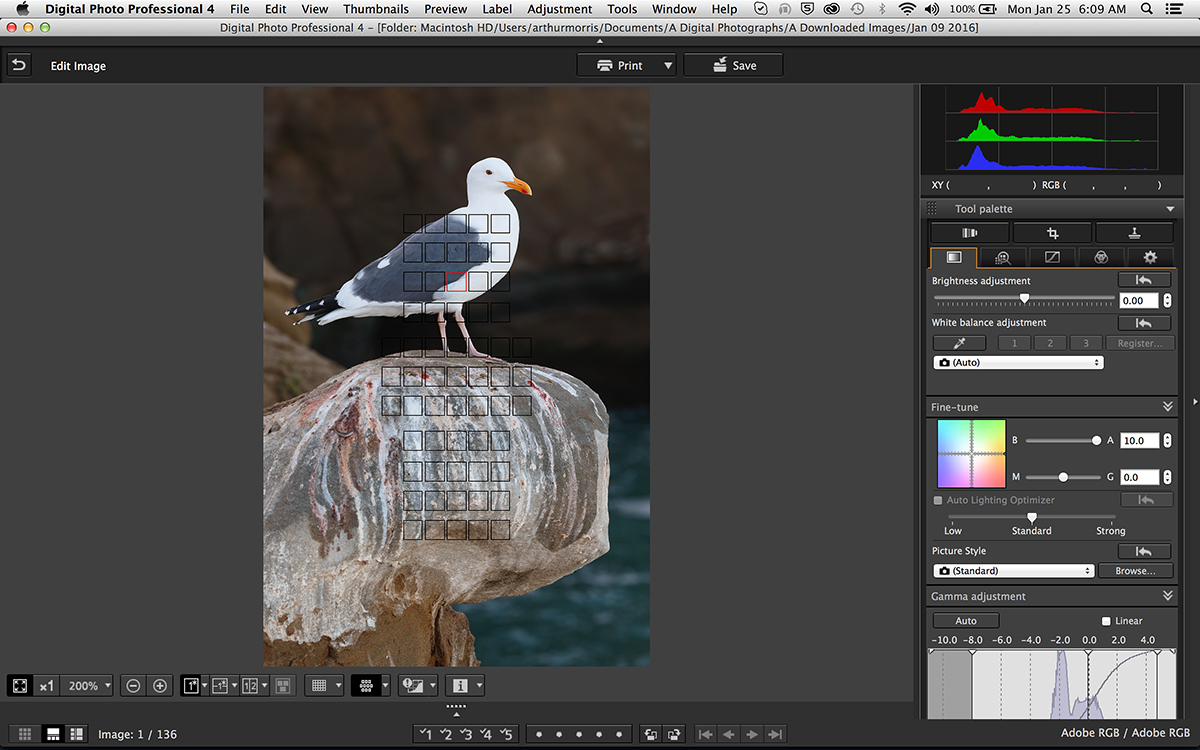
|
This is the DPP 4 screen capture for today’s featured image.
|
DPP 4 Color Balance Fine-Tune Tip
Captured with AWB, today’s featured image had a big blue color cast as expected as the subject and the whole scene were in the shade. Rather than trying Click White Balance or adjust the Color Temperature slider, I simply moved the B/A (Blue/Aqua) slider all the way to the right toward Aqua. This pretty much balanced the R, the G, and the B in the histogram and thus, the results were quite pleasing.
Note also the location of the carefully chosen AF point that is illuminated in red. Learning to move the AF point around quickly and efficiently will help you immeasurably to improve the design of your images.
|
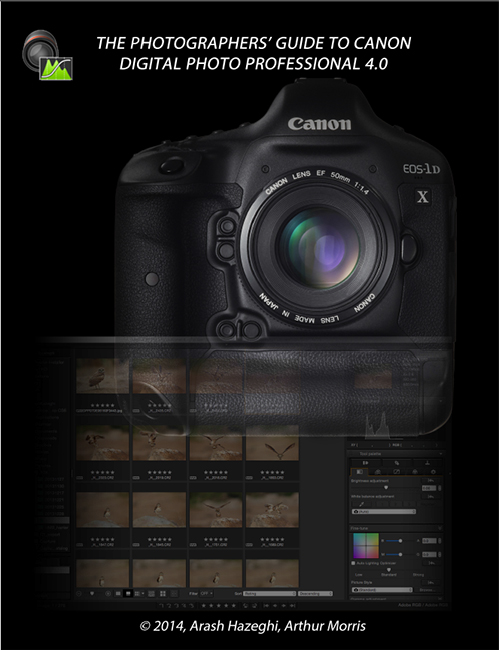
|
|
You can order your copy of “The Photographers’ Guide to Canon Digital Photo Professional 4.0” (aka the DPP 4 Raw Conversion eGuide) by Arash Hazeghi and Arthur Morris by clicking here.
|
The DPP 4 eGuide (PDF)
Learn how and why I and many other discerning photographers choose and use only DPP 4 to convert their Canon RAW files in the DPP 4 RAW Conversion Guide by Arash Hazeghi and yours truly. The latest version supports all of the newer Canon camera bodies and several older models including the EOS-7D and the EOS-1D Mark IV. The DPP IV Guide is the ideal companion to the 7D Mark II User’s Guide, a runaway best seller.
The DPP 4 eGuide (PDF) Updated for 1D Mark IV and the original 7D
The DPP 4 eGuide was recently updated to include the luminance and chrominance noise reduction values for both the 1D Mark IV and the original 7D. If you purchased your copy from BAA please e-mail Jim and request the DPP 4 1D IV/7D update. Please be sure to cut and paste page 1 of the guide into your e-mail as proof of purchase.
2017 San Diego 4 1/2-DAY BIRDS AS ART Instructional Photo-Tour (IPT) JAN 11 thru and including the morning session on JAN 15: 4 1/2 days: $1999.
(Limit: 10/openings 8)
Meet and Greet at 7:00pm on the evening before the IPT begins; Tuesday 1/10/17.
Join me in San Diego to photograph the spectacular breeding plumage Brown Pelicans with their fire-engine red and olive green bill pouches; Brandt’s and Double-crested Cormorants; breeding plumage Wood and Ring-necked Duck; other duck species possible including Lesser Scaup, Redhead, and Surf Scoter; a variety of gulls including Western, California, and the gorgeous Heerman’s, all in full breeding plumage; shorebirds including Marbled Godwit, Willet, Sanderling and Black-bellied Plover; many others possible including Least, Western, and Spotted Sandpiper, Whimbrel, Black and Ruddy Turnstone, Semipalmated Plover, and Surfbird; Harbor Seals (depending on the current regulations) and California Sea Lions; and Bird of Paradise flowers. And as you can see by studying the two IPT cards there are some nice bird-scape and landscape opportunities as well.
With gorgeous subjects just sitting there waiting to have their pictures taken, photographing the pelicans on the cliffs is about as easy as nature photography gets. With the winds from the east almost every morning there is usually some excellent flight photography. And the pelicans are almost always doing something interesting: preening, scratching, bill pouch cleaning, or squabbling. And then there are those crazy head throws that are thought to be a form of intra-flock communication.
Did I mention that there are wealth of great birds and natural history subjects in San Diego in winter?
For complete 2017 San Diego ITP info please click here.
Please Remember to use our Affiliate Links 🙂
To show your appreciation for my continuing efforts here, we ask, as always, that you get in the habit of using my B&H affiliate links on the right side of the blog for all of your photo and electronics purchases. Please check the availability of all photographic accessories in the BIRDS AS ART Online Store, especially the Mongoose M3.6 tripod heads, Gitzo tripods, Wimberley heads and plates, LensCoats and accessories, and the like. We sell only what I have used, have tested, and can depend on. We will not sell you junk. We know what you need to make creating great images easy and fun. And we are always glad to answer your gear questions via e-mail. I just learned that my account was suspended during my absence; it should be up and running by Monday at the latest.
I would of course appreciate your using our B&H affiliate links for all of your major gear, video, and electronic purchases. For the photographic stuff mentioned in the paragraph above we, meaning BAA, would of course greatly appreciate your business. Here is a huge thank you to the many who have been using our links on a regular basis and visiting the BAA Online store as well.
Facebook
Be sure to like and follow BAA on Facebook by clicking on the logo link upper right. Tanks a stack!
Typos
In all blog posts and Bulletins, feel free to e-mail or to leave a comment regarding any typos or errors. Just be right 🙂
January 24th, 2016 What’s Up?
Scoff at Cold Thermogenesis and ice baths if you like, but the facts are that while I was in San Diego I was getting up every 45 minutes to an hour for a pit stop and sleeping–if you could even call it that–only five to six hours. Last night, after my fourth day in a cold pool–about 73 degrees, and after four 6pm ice baths, I slept eight full hours with just one pit stop.
I spent most of yesterday working on a South Georgia article for Nature Photographer magazine. After I finish that up this morning I will be doing some more work on my coming soon Southern Ocean Photography Guide and working a bit on the After-Conversion Photoshop Guide that I will be doing with Arash Hazeghi. (See more on that below.)
I am looking forward to the two NFL games today. I am hoping that Carolina wins but would be OK if the Cardinals beat them. I will be investing all of my rooting energy against the hated Patriots. Just why did Pretty Boy Tom Brady destroy his cell phone before being investigated by the league??? Go Peyton!

B&H
B&H was the primary exhibition sponsor of my solo, career retrospective, 67-image exhibit at the San Diego Natural History Museum. Thank them (and me, for the work I do on the blog) by clicking on the logo link above to shop for camera bodies and lenses.
|
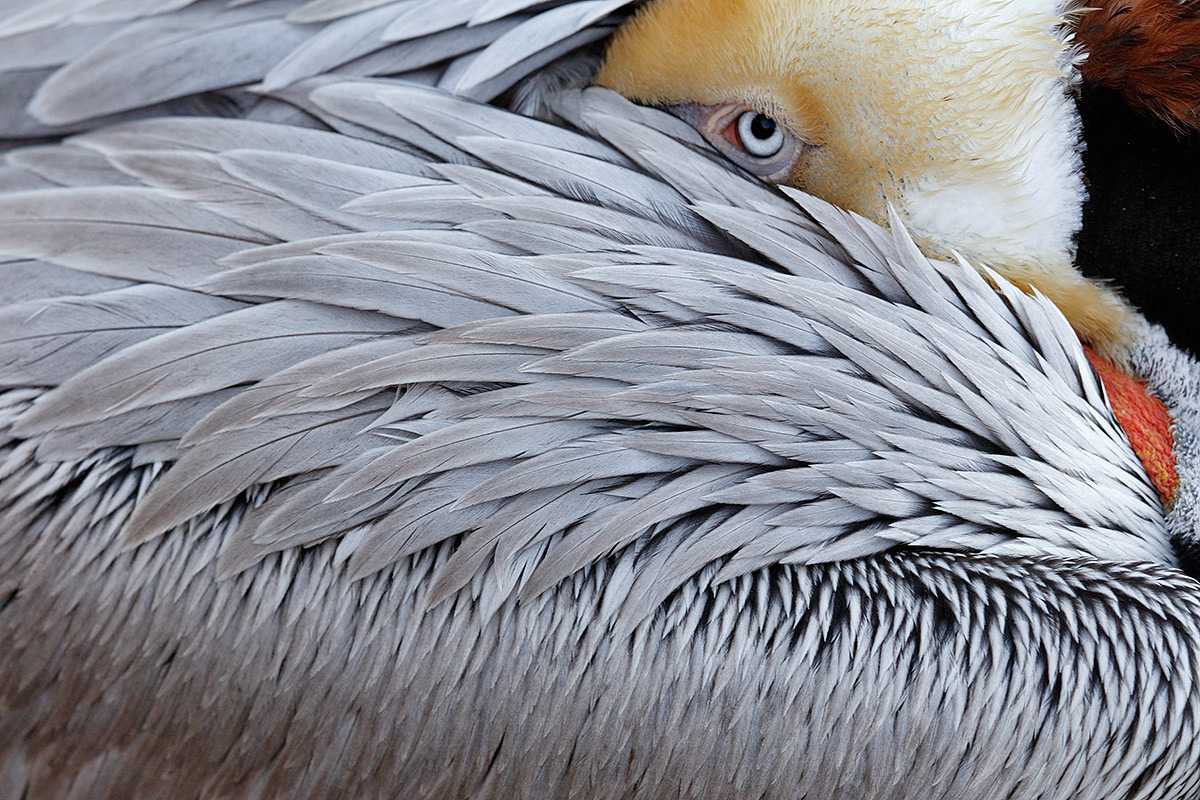
|
|
This image was created at La Jolla, CA with the Induro GIT 304L/Mongoose M3.6-mounted Canon EF 500mm f/4L IS II USM lens, the Canon Extender EF 1.4X III, and the Canon EOS 5DS R. ISO 1600. Evaluative metering +1/3 stop: 1/60 sec. at f/8. AWB. Should have been +1 stop…
Center AF point/AI Servo Expand/Rear Focus AF as framed was active at the moment of exposure. Click here to see the latest version of the Rear Focus Tutorial. Click on the image to see a larger version.
Brown Pelican scapulars viewed from overhead with eye visible
|
ISO 1600 5DS R Noise
Before scrolling down to look at the three tight crops below, consider the noise levels that you see at ISO 1600 in the image as presented above–please click on the image to view it larger if you wish. The only obvious noise that I am seeing is in the rather “mushy” area in the lower left corner. That “mushy” look may not be noise at all as that area is somewhat shadowed and thus a bit underexposed… Please leave a comment and let us know what you are seeing as far as noise in the image as presented above.
Full Frame
The challenge for me here while shooting almost straight down from above the pelican was to completely fill the frame with feathers while totally eliminating any evidence of the reddish cliff background in the corners. This image is full frame: I was able to get what I wanted.
Thanks Carlotta for Teaching an Old Dog a New Trick
I first met Carlotta Grenier on one of the 2015 Bosque IPTs. She had so much fun that she signed up for the San Diego IPT that turned out to be a blast. During the image critiquing session she shared one image that captivated me. She had shot straight down at the head and back of a sleeping pelican. Over the years I had done some similar stuff in the same general area but had not shot straight down as she had. So thanks Carlotta for opening my eyes.
Rather than rear focusing on the bird’s eye, I went with the active AF point on the scapulars as I wanted those feathers absolutely sharp. I figured that t f/8 that I had a chance of getting the eye sharp. I succeeded half way but a Contrast Mask rendered the eye more than sharp enough for me. With the eye somewhat in a shaded area I did some Eye Doctor work by making the pupil blacker and making the iris whiter, all via small Quick Masks followed by Curves on a Layer (Control + M). The Eye Doctor work really brought the image to life.
You say Car-LOT-uh…
At the beginning of the IPT I kept mispronouncing Carlotta’s name by saying Car-LOW-tah. Once she corrected me a few times (in good fun I might add), I had it down pat, Car-LOT-uh. The problem was that others had become confused. Folks who had gotten her name right at first were now calling her Car-LOW-tah and even Car-LEE-tah. Everyone, including Carlotta, had a good laugh. And a great time on the IPT.
|
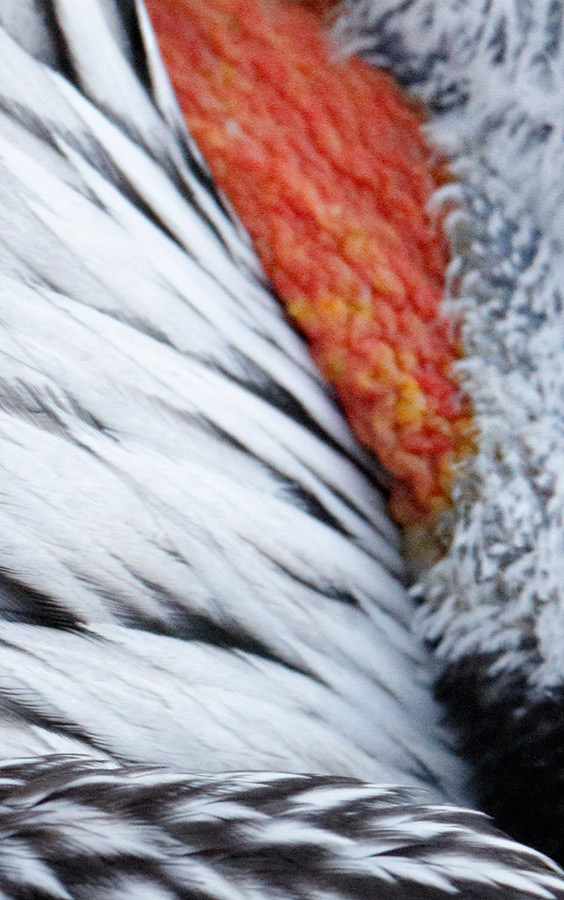
|
Tight crop #1: The unsharpened crop here approximates a 100% crop. It was downsized just a bit to 900 pixels tall. The 850kb file was optimized to < 395 kb and is presented here at 466 pixels wide.
|
|
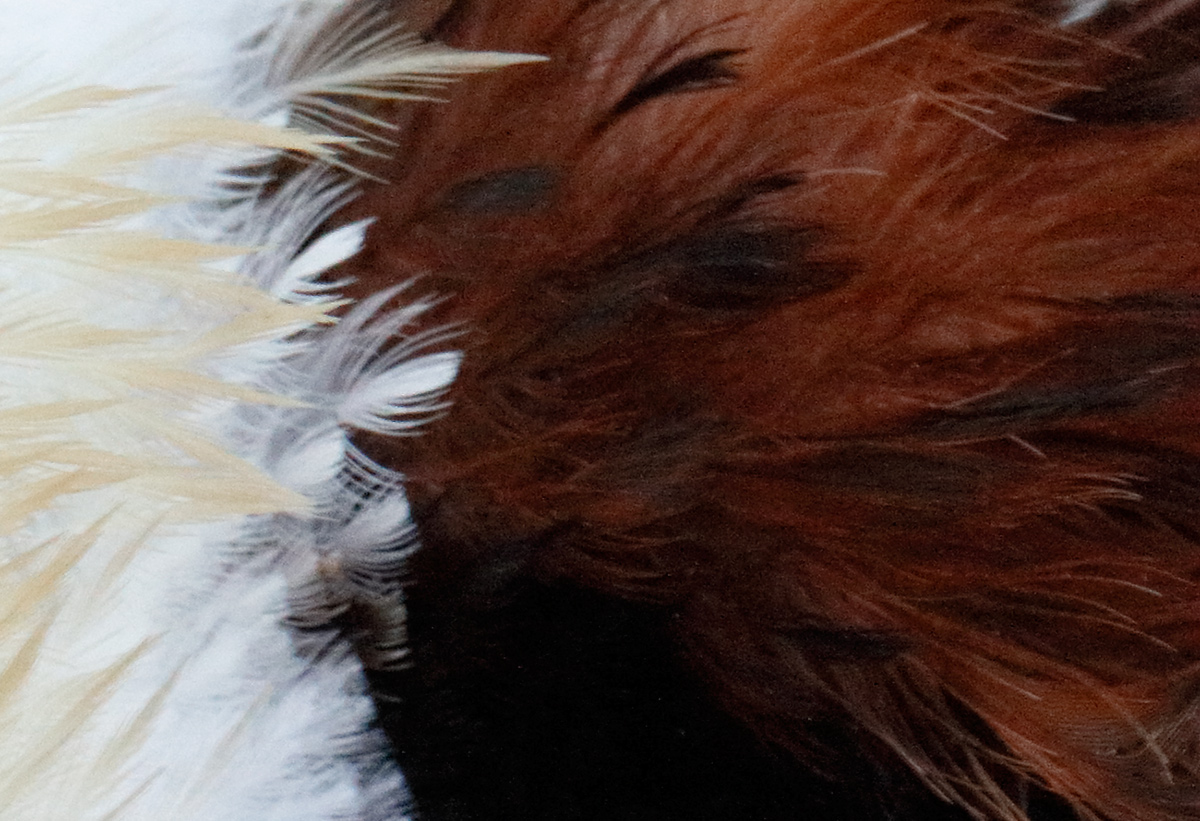
|
Tight crop #2: The unsharpened crop here approximates a 100% crop. That was cropped to 1200 pixels wide. The approximately 600 kb file was optimized to < 395 kb. It is presented here at 800 pixels wide.
|
|
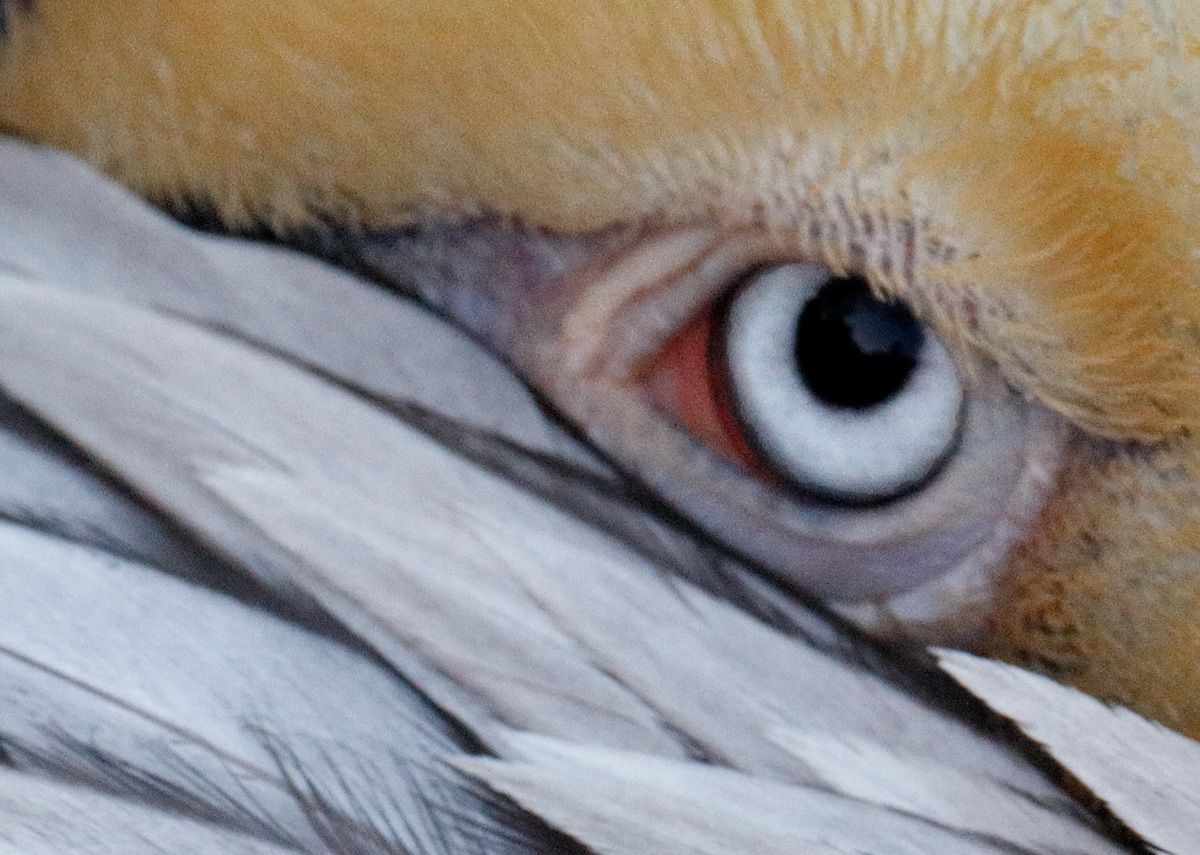
|
Tight crop #3: The unsharpened crop here also approximates a 100% crop. It was downsized just a bit to 1200 pixels wide. The 600kb file was optimized to < 395 kb and is presented here at 800 pixels wide.
|
First, My Comments on Noise
I must admit that since I began doing my conversions in DPP 4 and using the Chrominance and Luminance Noise Reduction Values developed by Arash Hazeghi as summarized on page 28 of the DPP 4 RAW Conversion Guide. Heck, I was never really concerned about noise even before I started using DPP. That may–in part–be due to the fact that I have long minimized noise by pushing my exposure far to the right in the field.
Right now I am editing Arash’s “After-Conversion Photoshop Guide” (my working title) and am learning a lot more about noise and about the Neat Image noise reduction plug-in. Arash recommends Neat Image Pro so that is what I installed on my MacBook Pro yesterday. I still have lots of work to do in that area so I will say succinctly that I am no expert in the noise department (even though I often peek at big enlargements of small areas of an image).
Fine Feather Detail, Image Quality, and Noise Questions
If and only if you are familiar with looking at 100% crops you are invited to comment on image quality, chrominance (color) noise, luminance noise, and on the fine feather detail that you are seeing in the three tight crops above.
2017 San Diego 4 1/2-DAY BIRDS AS ART Instructional Photo-Tour (IPT) JAN 11 thru and including the morning session on JAN 15: 4 1/2 days: $1999.
(Limit: 10/openings 8)
Meet and Greet at 7:00pm on the evening before the IPT begins; Tuesday 1/10/17.
Join me in San Diego to photograph the spectacular breeding plumage Brown Pelicans with their fire-engine red and olive green bill pouches; Brandt’s and Double-crested Cormorants; breeding plumage Wood and Ring-necked Duck; other duck species possible including Lesser Scaup, Redhead, and Surf Scoter; a variety of gulls including Western, California, and the gorgeous Heerman’s, all in full breeding plumage; shorebirds including Marbled Godwit, Willet, Sanderling and Black-bellied Plover; many others possible including Least, Western, and Spotted Sandpiper, Whimbrel, Black and Ruddy Turnstone, Semipalmated Plover, and Surfbird; Harbor Seals (depending on the current regulations) and California Sea Lions; and Bird of Paradise flowers. And as you can see by studying the two IPT cards there are some nice bird-scape and landscape opportunities as well.
With gorgeous subjects just sitting there waiting to have their pictures taken, photographing the pelicans on the cliffs is about as easy as nature photography gets. With the winds from the east almost every morning there is usually some excellent flight photography. And the pelicans are almost always doing something interesting: preening, scratching, bill pouch cleaning, or squabbling. And then there are those crazy head throws that are thought to be a form of intra-flock communication.
Did I mention that there are wealth of great birds and natural history subjects in San Diego in winter?
For complete 2017 San Diego ITP info please click here.
Please Remember to use our Affiliate Links 🙂
To show your appreciation for my continuing efforts here, we ask, as always, that you get in the habit of using my B&H affiliate links on the right side of the blog for all of your photo and electronics purchases. Please check the availability of all photographic accessories in the BIRDS AS ART Online Store, especially the Mongoose M3.6 tripod heads, Gitzo tripods, Wimberley heads and plates, LensCoats and accessories, and the like. We sell only what I have used, have tested, and can depend on. We will not sell you junk. We know what you need to make creating great images easy and fun. And we are always glad to answer your gear questions via e-mail. I just learned that my account was suspended during my absence; it should be up and running by Monday at the latest.
I would of course appreciate your using our B&H affiliate links for all of your major gear, video, and electronic purchases. For the photographic stuff mentioned in the paragraph above we, meaning BAA, would of course greatly appreciate your business. Here is a huge thank you to the many who have been using our links on a regular basis and visiting the BAA Online store as well.
Facebook
Be sure to like and follow BAA on Facebook by clicking on the logo link upper right. Tanks a stack!
Typos
In all blog posts and Bulletins, feel free to e-mail or to leave a comment regarding any typos or errors. Just be right 🙂
|
|
























